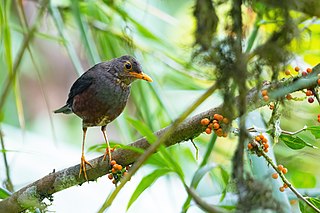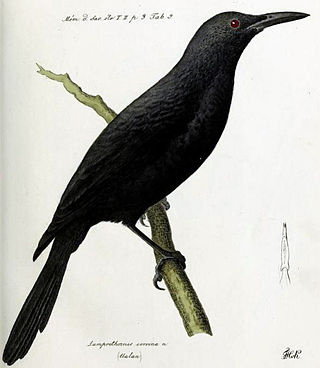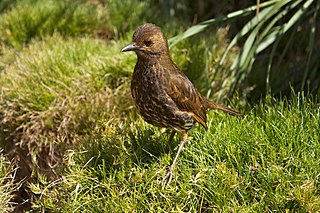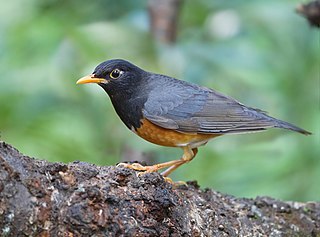
The South Island piopio also known as the New Zealand thrush, was a passerine bird of the family Oriolidae.

The island thrush is a common forest bird in the thrush family. Almost 50 subspecies have been described, ranging from South East Asia and Melanesia, to Samoa, exhibiting great differences in plumage. Several subspecies are threatened and three have already become extinct.

The Cuban macaw or Cuban red macaw is an extinct species of macaw native to the main island of Cuba and the nearby Isla de la Juventud. It became extinct in the late 19th century. Its relationship with other macaws in its genus was long uncertain, but it was thought to have been closely related to the scarlet macaw, which has some similarities in appearance. It may also have been closely related, or identical, to the hypothetical Jamaican red macaw. A 2018 DNA study found that it was the sister species of two red and two green species of extant macaws.
The Taita thrush, also known as the Taita olive thrush or Heller's ground thrush, is an endangered bird from the family of thrushes (Turdidae), endemic to the Taita Hills in Kenya.

The olive thrush is, in its range, one of the most common members of the thrush family (Turdidae). It occurs in African highlands from southern Malawi and Mozambique in the north to the Cape of Good Hope in the south. It is a bird of forest and woodland, but has locally adapted to parks and large gardens in suburban areas.

The Raiatea parakeet or Society parakeet, also known as the Society kakariki or brown-headed parakeet, is an extinct parakeet of the genus Cyanoramphus.

The Kosrae starling, also known as Kosrae Island starling, and formerly as Kusaie Mountain starling, is an extinct bird from the family of starlings (Sturnidae). It was endemic to the montane forests on the island of Kosrae which belong to the Caroline Islands in the south-western Pacific.

The Marianne white-eye, also known as Seychelles chestnut-sided white-eye or Seychelles yellow white-eye, is an extinct species of small bird in the white-eye family.
The Tasman starling was described in 1836 by John Gould as a species which occurred on both Norfolk Island and Lord Howe Island. In 1928 Australian ornithologist Gregory Mathews recognized that the plumage of the race from Lord Howe Island was much browner and more greyish than the plumage of the Norfolk Island race and split the species into two forms, the Norfolk starling, and the Lord Howe starling. Both subspecies are now extinct, thus so the species.

The Lord Howe thrush, also known as the vinous-tinted thrush or vinous-tinted blackbird, is an extinct subspecies of the island thrush. It was endemic to Lord Howe Island, an Australian island in the Tasman Sea, where it was also called the doctor bird or ouzel by the islanders.

The O‘ahu ‘ō‘ō was a member of the extinct genus of the ‘ō‘ōs (Moho) within the extinct family Mohoidae. It was previously regarded as member of the Australo-Pacific honeyeaters (Meliphagidae).

The Tristan thrush, also known as the starchy, is a species of bird in the thrush family that is endemic to the British overseas territories of the isolated Tristan da Cunha archipelago in the South Atlantic Ocean.

The Comoro thrush is a species of bird in the family Turdidae. It is found in the Comoros Islands in the south western Indian Ocean.

The black-breasted thrush is a species of bird in the family Turdidae. It is found from north-eastern India to northern Vietnam. Although both male and female birds have the same colour on their lower parts, the upper section of males is mostly black in colour, while females are mostly grey-brown. Thus, the bird's common name refers to the colour of the male bird's breast. They tend to live in forests located at high altitude.

The white-eyed thrush is a species of bird in the family Turdidae that is endemic to Jamaica. Its natural habitats are subtropical or tropical moist lowland forests, subtropical or tropical moist montane forests, and heavily degraded former forest.

The red-legged thrush is a species of bird in the family Turdidae. Native to the Caribbean, it is found in the Bahamas, Cayman Islands, Cuba, Dominica, Hispaniola and Puerto Rico. It formerly occurred on the Swan Islands, Honduras, but was extirpated there.

The Tibetan blackbird is a species of bird in the thrush family Turdidae. It is found in the Himalayas from northern Pakistan to southeastern Tibet. Originally described as a separate species by Henry Seebohm in 1881, it was then considered a subspecies of the common blackbird until 2008, when phylogenetic evidence revealed that it was only distantly related to the latter species. It is a relatively large thrush, having an overall length of 23–28 centimetres. Males are blackish-brown all over with darker plumage on the head, breast, wings and tail and dull orange-yellow bills, while females have browner underparts, faint streaking on the throat, and a dull darkish yellow bill. Both sexes may seem slightly hooded. It can be differentiated from the common blackbird by its complete lack of an eye-ring and reduced song.

The Raiatea starling, formerly known as the bay thrush, bay starling, or the mysterious bird of Ulieta, is an extinct bird species of uncertain taxonomic relationships that once lived on the island of Raiatea, the second largest of the Society Islands in French Polynesia.

The Grand Cayman bullfinch is a threatened bird endemic to the island of Grand Cayman. It is the only bird species endemic to the Cayman Islands since the extinction of the Grand Cayman thrush, though several bird subspecies are also endemic.


















